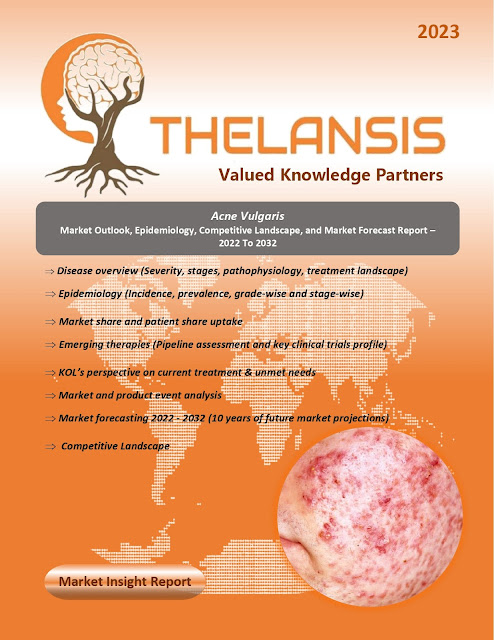GM1 Gangliosidosis – Market Outlook, Epidemiology, Competitive Landscape, and Market Forecast Report – 2023 To 2033
GM1
gangliosidosis is a rare inherited lysosomal storage disorder characterized by
a deficiency of the enzyme beta-galactosidase. This enzyme breaks down
gangliosides, a type of lipid found in cell membranes. When beta-galactosidase
is deficient, gangliosides accumulate in cells, particularly in the nervous
system. There are three clinical subtypes of GM1 gangliosidosis, classified by
age of symptom onset:
1.
Infantile (type 1): This is the most common
and severe form of GM1 gangliosidosis, with symptom onset by six months and
death by two to four years. Affected infants typically appear normal at birth
but soon develop neurological symptoms such as hypotonia (weakness), seizures,
and developmental delay.
2.
Late infantile/juvenile (type 2): This form of
GM1 gangliosidosis presents as early as 7 months and as late as five years of
age, with death occurring in mid-childhood to early adulthood. Affected
children typically have a milder disease course than those with infantile GM1
but still experience a progressive neurological decline.
3.
Adult/chronic (type 3): This is the least
severe form of GM1 gangliosidosis, with slower disease progression and symptom
onset from early childhood to the late teens. Affected individuals may
experience various symptoms, including neurological problems, psychiatric
symptoms, and visceral (internal organ) problems.
The
prognosis for GM1 gangliosidosis depends on the subtype. Patients with
infantile GM1 have the poorest prognosis, most dying by two to four years of
age. Patients with late infantile/juvenile GM1 have a longer life expectancy
but still experience progressive neurological decline. Adult/chronic GM1
patients have the best prognosis but may still experience significant
disability. There is no cure for GM1 gangliosidosis, but there are treatments
that can help manage the symptoms and improve the quality of life for affected
individuals. Treatment options include anticonvulsants to control seizures,
gastrostomy tubes to ensure proper nutrition and hydration, and procedures to
maintain an open airway. Diagnosis of GM1 gangliosidosis is typically made by
measuring beta-galactosidase enzyme activity in white blood cells or skin
cells. Genetic testing can also be used to confirm the diagnosis. Current
treatment options for GM1 gangliosidosis are limited to palliative and
supportive care. However, several promising new therapies are developing,
including gene and enzyme replacement therapies. These therapies can
potentially slow the progression of the disease and improve the quality of life
for affected individuals.
·
According to Thelansis, the overall prevalence
of GM1 gangliosidosis at birth is approximately 1.5 to 2.1 per 100,000 live
births.
Thelansis’s
“GM1 Gangliosidosis Market Outlook, Epidemiology, Competitive Landscape, and
Market Forecast Report – 2023 To 2033" covers disease overview,
epidemiology, drug utilization, prescription share analysis, competitive
landscape, clinical practice, regulatory landscape, patient share, market
uptake, market forecast, and key market insights under the potential GM1
Gangliosidosis treatment modalities options for eight major markets (USA,
Germany, France, Italy, Spain, UK, Japan, and China).
KOLs insights of GM1 Gangliosidosis
across 8 MM market from the centre of Excellence/ Public/ Private hospitals
participated in the study. Insights around current treatment landscape,
epidemiology, clinical characteristics, future treatment paradigm, and Unmet
needs.
GM1
Gangliosidosis Market Forecast Patient Based Forecast Model (MS.
Excel Based Automated Dashboard), which Data Inputs with sourcing, Market
Event, and Product Event, Country specific Forecast Model, Market uptake and
patient share uptake, Attribute Analysis, Analog Analysis, Disease burden, and
pricing scenario, Summary, and Insights.
Thelansis Competitive Intelligence (CI) practice
has been established based on a deep understanding of the pharma/biotech
business environment to provide an optimized support system to all levels of
the decision-making process. It enables business leaders in forward-thinking
and proactive decision-making. Thelansis supports scientific and commercial
teams in seamless CI support by creating an AI/ ML-based technology-driven
platform that manages the data flow from primary and secondary sources.
Tags: GM1
Gangliosidosis, GM1 Gangliosidosis market outlook, GM1
Gangliosidosis competitive landscape, GM1
Gangliosidosis market forecast, Thelansis, Primary
market research, KOL insights, Competitive Intelligence (CI)




Comments
Post a Comment